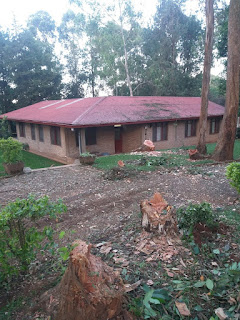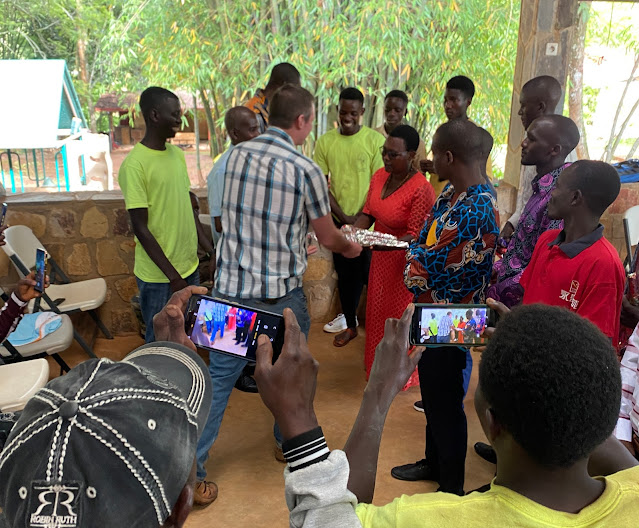(from Eric)
Saturday, Rachel and I were in the city to attend the wedding of Dr. Jean de Dieu. Jean de Dieu was once our medical student at Kibuye. He graduated about five years ago, and shortly after, he got a job working as a generalist doctor at Kibuye, mostly on the maternity service. We have seen him grow in his ability to take care of patients and lead in many different hospital areas. He does so calmly and wisely, being the kind of doctor that we would both want to work with and also be treated by.
 |
| Jean de Dieu and Guillaine: the happy couple |
So it was a joy to go to his wedding. We had received the invitation and knew where the church was because of some other weddings a few years ago. We got there in the pouring rain, only to find it empty. We called a friend who informed us that the church of the same name is now in a different part of town, but he would meet us at a known landmark and direct us. So we drove through the rain of Bujumbura, finding our friend and letting him guide us (a bit late) to the ceremony.
The power was out, but the church was well lit with natural light. Honestly, we couldn't hear much because of the rain on the metal roof sheeting, but we could see a joyful couple become one, so I guess that's all that mattered. Right at the moment of the processional, the power came back on. The timing was perfect in my opinion, since they had planned an awesome dancing-exit/conga-line, and the blasting music served the effect very well indeed.
 |
| The elegant reception |
It was joyful. Joyful for Dr. Jean de Dieu, and that joy spilled over, even to me. Later, at the reception in another part of town, we saw former students that we hadn't seen in years, church friends that we met when we first came to Burundi, as well as numerous current hospital staff who had found a way to the wedding despite a nationwide fuel shortage.
***
But we had to leave before the very end of the reception. We needed to get back to our hotel. We had a funeral to attend.
I met James Paternoster my first year of medical school where he was working with the Christian medical student group via Intervarsity. He was then the same age that I am now. In James, I found a wise and extremely well-read friend. In his family, Rachel and I found a warm and welcoming home.
James grew up in Nigeria and Niger, and when we decided to move to Africa with the Cropseys and Faders, James formed part of the three-headed think tank we referred to as the Lyntelnoster. After less than a year in Kenya, we found ourselves organizing a mini-retreat and we needed a speaker. James agreed to come out and visit, and I'm so glad I got to be in Africa with him.
 |
| James on the far left leading our retreat |
This past January, James was diagnosed with a glioblastoma in his brain, and after 10 months of very faithfully walking that road, he passed away. I was honored to record a short eulogy and send it for the memorial service, of which Rachel and I now needed to get back to the hotel for the livestream.
We got to see friends on camera, friends singing in praise of God, friends sharing about James and what he taught them. James' eldest son Abraham (and possibly Kibuye's most legendary intern ever) spoke well of his dad.
It was sad and sorrowful, and...joyful. As the homily said: The opposite of joy is not sorrow, but hopelessness. And James' memorial service was definitely not hopeless.
A good friend shared at the service these words from James just before he passed away: "Joy is deep. The fear comes and goes, and when it comes, it's hard. But joy is deeper and it remains."
***
The juxtaposition of the wedding and the funeral was striking, but not as weird as one might think. James' wife Barb talked about how much "James loved a good funeral", because of how it could be a reflection on a life well-lived, and a good marriage is part of such a life. The joy of the wedding was different than the joy of the funeral. One was happy and the other sorrowful. Strange that we can still somehow know the thing we call joy in the midst of both of them. Humankind is not usually so discerning, but somehow we figured this one out.
James' second son Paul led the congregation is a catechism reading:
Q: What is your only comfort in life AND death? (you can guess where I added the emphasis)
A: That I am not my own, but belong with body and soul, both in life AND in death, to my faithful Savior Jesus Christ
Saturday gave us a chance to reflect on both life and death, and to remember that our comfort in both is one and the same.


















































.jpeg)
